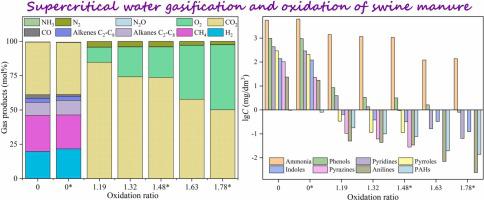当前位置:
X-MOL 学术
›
J. Supercrit. Fluids
›
论文详情
Our official English website, www.x-mol.net, welcomes your feedback! (Note: you will need to create a separate account there.)
Tracking contaminants in the aqueous effluent during supercritical water gasification and oxidation of swine manure in the flow mode
The Journal of Supercritical Fluids ( IF 3.9 ) Pub Date : 2024-02-22 , DOI: 10.1016/j.supflu.2024.106215 Oxana N. Fedyaeva , Sergey V. Morozov , Anatoly A. Vostrikov
The Journal of Supercritical Fluids ( IF 3.9 ) Pub Date : 2024-02-22 , DOI: 10.1016/j.supflu.2024.106215 Oxana N. Fedyaeva , Sergey V. Morozov , Anatoly A. Vostrikov

|
Biomass waste processing is an area of great interest due to its potential for reducing environmental impact and recovering resources. The present work investigates for the first time the composition of products resulting from supercritical water (SCW) gasification and oxidation of swine manure (SM) continuously fed into a tubular reactor at a temperature gradient along its vertical axis of 390–600 °C and a pressure of 25 MPa. Special attention is paid to how the operating parameters, including SM flow rate (6.5–10.7 g/min), oxidation ratio (OR ≤ 1.78), and the presence of NaOH additive (1 wt%) influenced the composition and concentration of contaminants (phenols, N-bearing aromatics, polyaromatic hydrocarbons (PAHs), and ammonia) in the effluent collected at the reactor outlet. The results of gas chromatography-mass spectrometry indicate that water-soluble products comprise predominantly of phenols, pyridines, pyrroles, indoles, pyrazines, anilines, and quinolines. Increasing the reagent’s residence time during SCW gasification was observed to lower the amount of phenols in the effluent. In addition, the introduction of NaOH increases the yields of syngas and NH while lowering the concentration of N-bearing aromatics and PAHs. SCW oxidation of SM not only reduces contaminant levels in the effluent by several orders of magnitude, but also partially compensates for thermal inputs needed for the process implementation. Among N-bearing compounds, ammonia, pyridines, indoles, and quinolines display the highest resistance to oxidation. The paper explores the resource-saving and ecological benefits of SCW gasification and oxidation of SM.
中文翻译:

在流动模式下跟踪超临界水气化和猪粪氧化过程中废水中的污染物
生物质废物处理因其在减少环境影响和回收资源方面的潜力而备受关注。目前的工作首次研究了猪粪(SM)的超临界水(SCW)气化和氧化所产生的产物的成分,该猪粪(SM)连续送入管式反应器,温度梯度沿其垂直轴为390-600°C,压力25兆帕。特别关注操作参数,包括 SM 流量 (6.5–10.7 g/min)、氧化比 (OR ≤ 1.78) 和 NaOH 添加剂 (1 wt%) 的存在如何影响污染物的成分和浓度(在反应器出口处收集的流出物中含有苯酚、含氮芳烃、多环芳烃 (PAH) 和氨。气相色谱-质谱分析结果表明,水溶性产物主要包含酚类、吡啶类、吡咯类、吲哚类、吡嗪类、苯胺类和喹啉类。据观察,在超临界水气化过程中增加试剂的停留时间可以降低流出物中的酚含量。此外,NaOH的引入增加了合成气和NH的产率,同时降低了含氮芳烃和PAH的浓度。 SM 的 SCW 氧化不仅将废水中的污染物水平降低几个数量级,而且还部分补偿了工艺实施所需的热输入。在含氮化合物中,氨、吡啶、吲哚和喹啉表现出最高的抗氧化性。本文探讨了SCW气化和SM氧化的资源节约和生态效益。
更新日期:2024-02-22
中文翻译:

在流动模式下跟踪超临界水气化和猪粪氧化过程中废水中的污染物
生物质废物处理因其在减少环境影响和回收资源方面的潜力而备受关注。目前的工作首次研究了猪粪(SM)的超临界水(SCW)气化和氧化所产生的产物的成分,该猪粪(SM)连续送入管式反应器,温度梯度沿其垂直轴为390-600°C,压力25兆帕。特别关注操作参数,包括 SM 流量 (6.5–10.7 g/min)、氧化比 (OR ≤ 1.78) 和 NaOH 添加剂 (1 wt%) 的存在如何影响污染物的成分和浓度(在反应器出口处收集的流出物中含有苯酚、含氮芳烃、多环芳烃 (PAH) 和氨。气相色谱-质谱分析结果表明,水溶性产物主要包含酚类、吡啶类、吡咯类、吲哚类、吡嗪类、苯胺类和喹啉类。据观察,在超临界水气化过程中增加试剂的停留时间可以降低流出物中的酚含量。此外,NaOH的引入增加了合成气和NH的产率,同时降低了含氮芳烃和PAH的浓度。 SM 的 SCW 氧化不仅将废水中的污染物水平降低几个数量级,而且还部分补偿了工艺实施所需的热输入。在含氮化合物中,氨、吡啶、吲哚和喹啉表现出最高的抗氧化性。本文探讨了SCW气化和SM氧化的资源节约和生态效益。



























 京公网安备 11010802027423号
京公网安备 11010802027423号